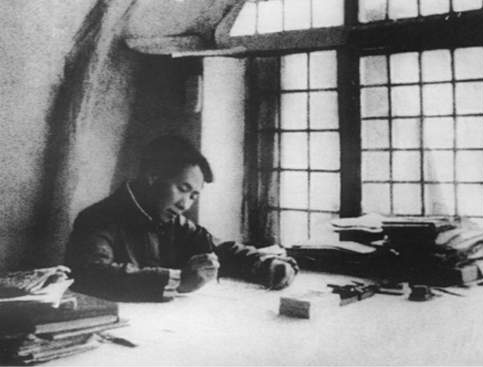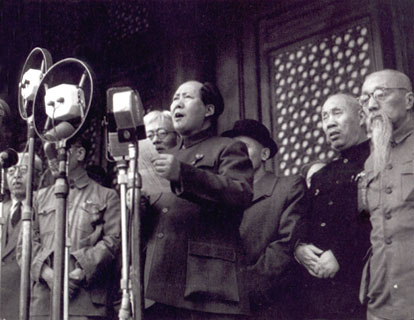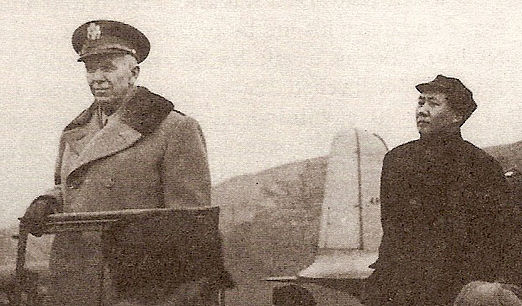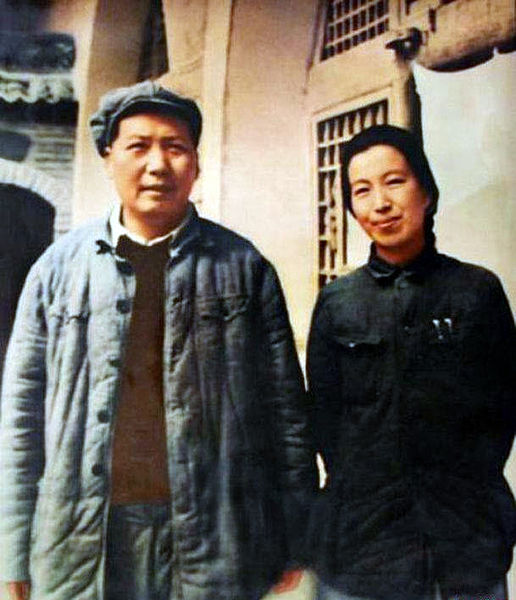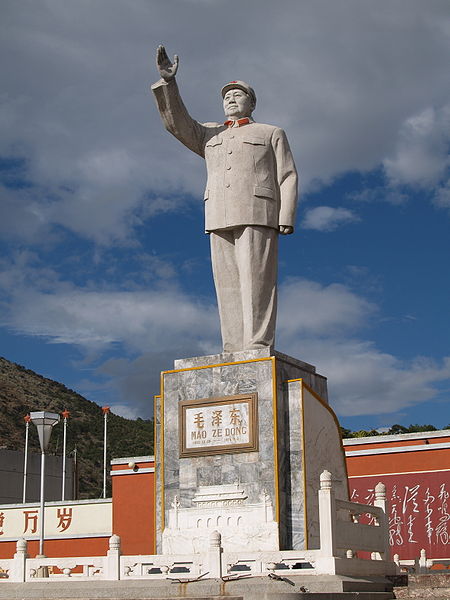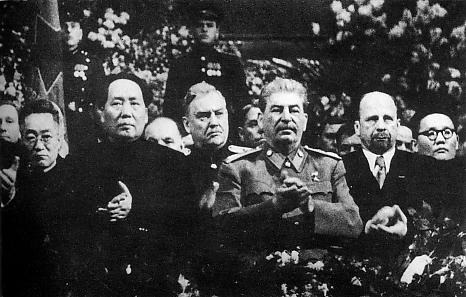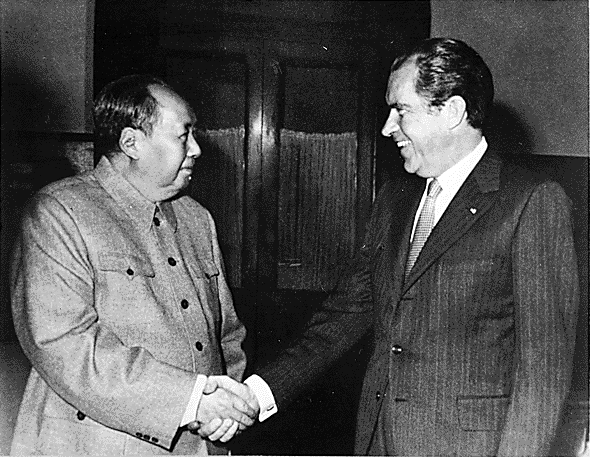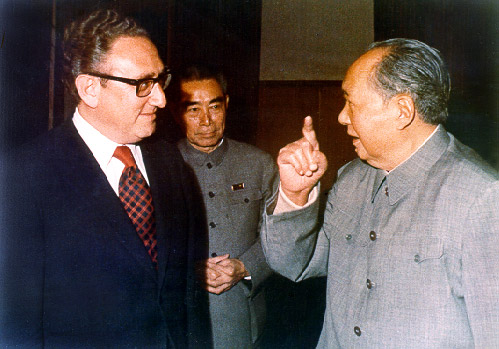<Back to Index>
- 1st Chairman of the Communist Party of China Mao Zedong, 1893
PAGE SPONSOR
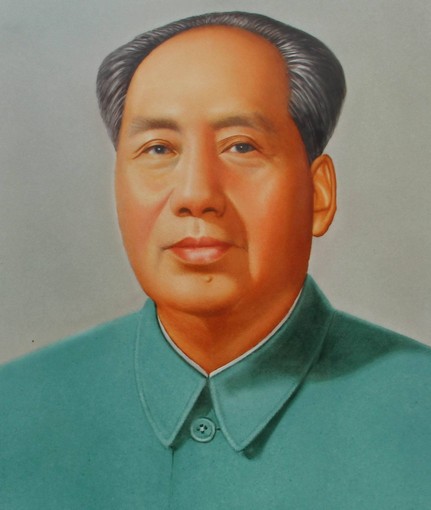
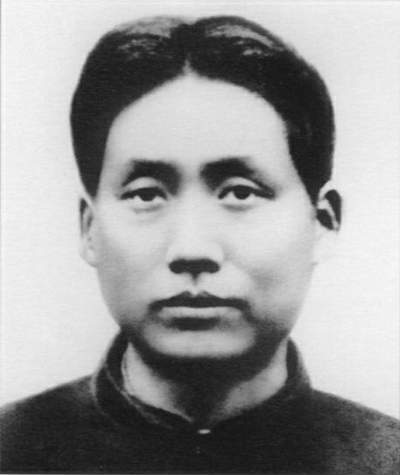
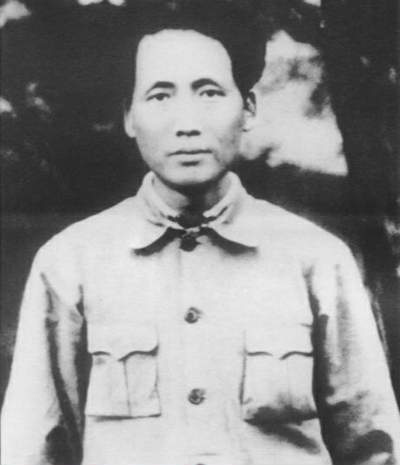
Mao Zedong, also transliterated as Mao Tse-tung, and commonly referred to as Chairman Mao (December 26, 1893 – September 9, 1976), was a Chinese Communist revolutionary, guerrilla warfare strategist, Marxist political philosopher, and leader of the Chinese Revolution. He was the architect and founding father of the People's Republic of China (PRC) from its establishment in 1949, and held control over the nation until his death in 1976. His theoretical contribution to Marxism – Leninism, along with his military strategies and brand of policies, are collectively known as Maoism.
Mao rose to power by commanding the Long March, forming a Second United Front with Kuomintang (KMT) during the Second Sino - Japanese War to repel a Japanese invasion, and later led the Chinese Communist Party (CCP) to victory against Generalissimo Chiang Kai-shek's KMT in the Chinese Civil War. Mao established political and military control over most of the territory formerly contained within the Chinese Empire and launched a campaign to suppress counterrevolutionaries. He sent the Communist People's Liberation Army into Xinjiang and Tibet but was unable to oust the remnants of the Nationalist Party from Taiwan. He enacted sweeping land reform by using violence and terror to overthrow landlords before seizing their large estates and dividing the land into people's communes. The Communist Party's final victory came after decades of turmoil in China, which included the Great Depression, a brutal invasion by Japan and a protracted civil war. Mao's Communist Party ultimately achieved a measure of stability in China, though Mao's efforts to close China to trade and market commerce, and eradicate traditional Chinese culture, have been largely rejected by his successors.
Mao styled himself "The Great Helmsman" and supporters continue to contend that he was responsible for some positive changes which came to China during his three decade rule. These included doubling the school population, providing universal housing, abolishing unemployment and inflation, increasing health care access, and dramatically raising life expectancy. A cult of personality grew up around Mao, and community dissent was not permitted. His Communist Party still rules in mainland China, retains control of media and education there and officially celebrates his legacy. As a result, Mao is still officially held in high regard by many Chinese as a great political strategist, military mastermind, and savior of the nation. Maoists promote his role as a theorist, statesman, poet, and visionary, and anti - revisionists continue to defend most of his policies.
In foreign policy, Mao initially sought to align China with Joseph Stalin's Soviet Union, although the Communist nations diverged after Stalin's death and towards the end of Mao's rule China began to open trade with the West. Elsewhere, Mao sent Chinese forces to war against the United Nations in the Korean War and saved the North Korean regime of Kim Il-sung and, despite financial woes in China, financed and supported Communist insurgencies across Asia — in Burma, Cambodia and elsewhere.
Mao remains a controversial figure to this day, with a contentious legacy that is subject to continuing revision and fierce debate. Nationwide political campaigns led by Mao, such as the Great Leap Forward and the Cultural Revolution, are often considered catastrophic failures. Mao encouraged population growth and although China's population almost doubled during the period of his leadership (from around 550 to over 900 million), his rule from 1949 to 1976 is believed to have caused the deaths of 40 to 70 million people. Severe starvation during the Great Chinese Famine, mass suicide as a result of the Three - anti and Five - anti campaigns, and political persecution during both the Anti - Rightist Movement purges and struggle sessions humiliations all resulted from these programs. His campaigns and their varying disastrous consequences are further blamed for damaging Chinese culture and society, as historical relics were destroyed and religious sites were ransacked.
While Mao's stated goals of combating bureaucracy, encouraging popular participation, and stressing China’s self - reliance are generally seen as laudable — and the rapid industrialization that
began during Mao's reign is credited for laying a foundation for
China’s development in the late 20th century — the harsh methods he used
to pursue them, including torture and executions, have been widely
rebuked as being ruthless and self - defeating. Because of his enormous impact, Mao is regarded as one of the most important figures in modern world history, and was named one of the 100 most influential people of the 20th century by Time magazine.
Mao was born on December 26, 1893, in Shaoshan, Hunan Province, China. His father was a poor peasant who became a prosperous farmer and grain dealer. At age 8 he began studying at the village primary school, but left school at 13 to work on the family farm. He later left the farm to continue his studies at a secondary school in Changsha, the capital of Hunan province. When the Xinhai Revolution against the Qing Dynasty broke out in 1911 he joined the Revolutionary Army in Hunan. In the spring of 1912 the war ended, the Republic of China was founded and Mao left the army. He eventually returned to school, and in 1918 graduated from the First Provincial Normal School of Hunan.
Following his graduation, Mao traveled to Beijing, where he lived with Yang Changji, his college teacher and future father - in - law, who had taken a position at Peking University. Yang recommended him highly: "These two people [Mao and Cai Hesen] are rare talents in China and will have a great future." At his recommendation, Mao worked as an assistant librarian at the University Library under the curator-ship of Li Dazhao, who would come to greatly influence Mao's future thought. Mao registered as a part - time student at Beijing University and attended a few lectures and seminars by intellectuals, such as Chen Duxiu, Hu Shi, and Qian Xuantong. After moving back to Changsha, he became headmaster of a school and was involved in provincial cultural and educational agitation. He renewed his friendship with Yang Kaihui, Professor Yang's daughter, eight years younger than he, and the two became lovers, then married despite Mao's earlier marriage with Luo Yixiu arranged by his father at home, which Mao never acknowledged. (In October 1930, the Kuomintang (KMT) captured Yang Kaihui as well as her son, Mao Anying). A number of his friends and future colleagues took advantage of the Mouvement Travail - Études to study in France, but Mao, perhaps because of a lack of ability to learn languages and the requirement to learn French, turned down the opportunity.
On July 23, 1921, Mao, now age 27, attended the first session of the National Congress of the Communist Party of China in Shanghai. Two years later, he was elected as one of the five commissars of the Central Committee of the Party during the third Congress session. Later that year, Mao returned to Hunan at the instruction of the CPC Central Committee to organize the Hunan branch of the Kuomintang after KMT premier Sun Yat-sen began a policy of active cooperation with the Chinese Communists.
In 1924, he was a delegate to the first National Conference of the Kuomintang, where he was elected an Alternate Executive of the Central Committee. That year he became an Executive of the Shanghai branch of the Kuomintang and Secretary of the Organization Department.
For a while, Mao remained in Shanghai, an important city that the CPC emphasized for the Revolution. However, the Party encountered major difficulties organizing labor union movements and building a relationship with its nationalist ally, the KMT. The Party had become poor, and Mao was disillusioned with the revolution and moved back to Shaoshan. During his stay at home, Mao's interest in the revolution was rekindled after hearing of the 1925 uprisings in Shanghai and Guangzhou. His political ambitions returned, and he then went to Guangdong, the base of the Kuomintang, to take part in the preparations for the second session of the National Congress of Kuomintang. In October 1925, Mao became acting Propaganda Director of the Kuomintang.
In early 1927, Mao returned to Hunan where,
in an urgent meeting held by the Communist Party, he made a report
based on his investigations of the peasant uprisings in the wake of the Northern Expedition. His "Report on the Peasant Movement in Hunan" is considered the initial and decisive step towards the successful application of Mao's revolutionary theories.
After graduating from the First Provincial Normal School of Hunan, the highest level of schooling available in his province, Mao spent six months studying independently. Mao was first introduced to communism while working at Peking University as a library assistant, and in 1921 he attended the organizational meeting of the Communist Party of China (or CPC). Important influences on Mao were the Russian revolution and, according to some scholars, the Chinese literary works: Outlaws of the Marsh and Romance of the Three Kingdoms. Mao sought to subvert the alliance of imperialism and feudalism in China. He thought the KMT to be both economically and politically vulnerable and thus that the revolution could not be steered by Nationalists.
Throughout the 1920s, Mao led several labor struggles based upon his studies of the propagation and organization of the contemporary labor movements. However, these struggles were successfully subdued by the government, and Mao fled from Changsha, Hunan, after he was labeled a radical activist. He pondered these failures and finally realized that industrial workers were unable to lead the revolution because they made up only a small portion of China's population, and unarmed labor struggles could not resolve the problems of imperial and feudal suppression. Mao began to depend on Chinese peasants who later became staunch supporters of his theory of violent revolution. This dependence on the rural rather than the urban proletariat to instigate violent revolution distinguished Mao from his predecessors and contemporaries. Mao himself was from a peasant family, and thus he cultivated his reputation among the farmers and peasants and introduced them to Marxism.
His two 1937 essays, "On Practice" and "on Contradiction", are
concerned with the practical strategies of a revolutionary movement and
stress the importance of practical, grass roots knowledge obtained
through experience. Both essays reflect the guerrilla roots of Maoism in
the need to build up support in the countryside against a Japanese
occupying force and emphasize the need to win over hearts and minds
through 'education'. The essays, excerpts of which appear in the 'Quotations from Chairman Mao Zedong',
warn against the behavior of the blindfolded man trying to catch
sparrows, and the 'Imperial envoy' descending from his carriage to
'spout opinions' .
Revolution is not a dinner party, nor an essay, nor a painting, nor a piece of embroidery; it cannot be so refined, so leisurely and gentle, so temperate, kind, courteous, restrained and magnanimous. A revolution is an insurrection, an act of violence by which one class overthrows another.— Mao Zedong
In 1927, after a large scale purge of Communists from the Kuomintang in Shanghai that ended their alliance during the Northern Expedition, Mao conducted the Autumn Harvest Uprising in Changsha as commander - in - chief. Mao led an army, called the "Revolutionary Army of Workers and Peasants", which was defeated by the KMT forces and scattered after fierce battles. Afterwards, the exhausted troops were forced to leave Hunan for Sanwan, Jiangxi, where Mao re-organized the scattered soldiers, rearranging the military division into smaller regiments. Mao also ordered that each company must have a party branch office with a commissar as its leader who would give political instructions based upon superior mandates. This military rearrangement in Sanwan, Jiangxi, initiated the CPC's absolute control over its military force and is considered to have had a fundamental and profound impact upon the Chinese revolution. Later, the army moved to the Jinggang Mountains, Jiangxi. In the Jinggang Mountains, Mao persuaded two local insurgent leaders to pledge their allegiance to him. There, Mao joined his army with that of Zhu De, creating the Workers' and Peasants' Red Army of China, Red Army in short. Mao's tactics were based on that of the Spanish Guerrillas during the Napoleonic Wars.
From 1931 to 1934, Mao helped establish the Soviet Republic of China and was elected Chairman of this small republic in the mountainous areas in Jiangxi. Here, Mao was married to He Zizhen. His previous wife, Yang Kaihui, had been arrested and executed in 1930, just three years after their departure. In Jiangxi, Mao's authoritative domination, especially that of the military force, was challenged by the Jiangxi branch of the CPC and military officers. Mao's opponents, among whom the most prominent was Li Wenlin, the founder of the CPC's branch and Red Army in Jiangxi, were against Mao's land policies and proposals to reform the local party branch and army leadership. Mao reacted first by accusing the opponents of opportunism and kulakism and then set off a series of systematic suppressions of them.
It is reported that horrible methods of torture were employed under Mao's direction and given names such as 'sitting in a sedan chair', 'airplane ride', 'toad - drinking water', and 'monkey pulling reins.' The wives of several suspects had their breasts cut open and their genitals burned. Short (2001) estimates that tens of thousands of suspected enemies, perhaps as many as 186,000, were killed during this purge. Critics accuse Mao's authority in Jiangxi of being secured and reassured through the revolutionary terrorism, or red terrorism.
Mao, with the help of Zhu De,
built a modest but effective army, undertook experiments in rural
reform and government, and provided refuge for Communists fleeing the
KMT purges in the cities. Mao's methods are normally referred to as
guerrilla warfare; but he himself made a distinction between guerrilla
warfare (youji zhan) and mobile warfare (yundong zhan).
Mao's doctrines of guerrilla warfare and mobile warfare were based upon
the fact of the poor armament and military training of the Red Army
which consisted mainly of impoverished peasants, who, however, were
fired by revolutionary passions and the aspiration for a communist
utopia.
Around 1930, there had been more than ten regions, usually entitled "soviet areas", under control of the CPC. The relative prosperity of "soviet areas" startled and worried Chiang Kai-shek, chairman of the Kuomintang government, who waged five waves of besieging campaigns against the "central soviet area." More than one million Kuomintang soldiers were involved in these five campaigns, four of which were defeated by the Red Army led by Mao. By June 1932 (the height of its power), the Red Army had no less than 45,000 soldiers, with a further 200,000 local militia acting as a subsidiary force.
Under increasing pressure from the KMT Encirclement Campaigns, there was a struggle for power within the Communist leadership. Mao was removed from his important positions and replaced by individuals (including Zhou Enlai) who appeared loyal to the orthodox line advocated by Moscow and represented within the CPC by a group known as the 28 Bolsheviks. Chiang, who had earlier assumed nominal control of China due in part to the Northern Expedition, was determined to eliminate the Communists. By October 1934, he had them surrounded, prompting them to engage in the "Long March", a retreat from Jiangxi in the southeast to Shaanxi in the north west of China. It was during this 9,600 kilometer (6,000 mi), year long journey that Mao emerged as the top Communist leader, aided by the Zunyi Conference and the defection of Zhou Enlai to Mao's side. At this Conference, Mao entered the Standing Committee of the Politburo of the Communist Party of China.
In 1936 Manchurian warlord and Chiang's former ally Zhang Xueliang decided to conspire with the CPC and kidnapped Chiang Kai-shek in Xi'an to force an end to the conflict between KMT and CPC. To secure the release of Chiang, the KMT was forced to agree to a temporary end to the Chinese Civil War and the forming of a United Front between the CPC and KMT against Japan. The alliance took place with salutary effects for the beleaguered CPC after relentless attacks by Chiang's forces. CPC agreed to form the New Fourth Army and the 8th Route Army which were nominally under the command of the National Revolutionary Army.
During the Sino - Japanese War, Mao advocated a strategy of avoiding open confrontations with the Japanese army and concentrate on guerrilla warfare from his base in Yan'an, while leaving the KMT to take on the brunt of the fighting and suffer tremendous casualties. Instead
Mao directed the CPC forces to concentrate on absorbing, and
eliminating if necessary, Chinese militia behind enemy lines. This led
to intensified conflicts between KMT and CPC forces, and the fragile
alliance broke down after the New Fourth Army incident in January 1941. Mao further consolidated power over the Communist Party in 1942 by launching the Shu Fan movement, or "Rectification" campaign against rival CPC members such as Wang Ming, Wang Shiwei, and Ding Ling. Also while in Yan'an, Mao divorced He Zizhen and married the actress Lan Ping, who would become known as Jiang Qing.
Mao also greatly expanded CPC's sphere of influence in areas outside of Japanese control, mainly through rural mass organizations, administrative, land and tax reform measures favoring poor peasants; while the Nationalists attempted to neutralize the spread of Communist influence by military blockade of areas controlled by CPC and fighting the Japanese at the same time.
In 1944, the Americans sent a special diplomatic envoy, called the Dixie Mission, to the Communist Party of China. According to Edwin Moise, in Modern China: A History 2nd Edition:
- Most of the Americans were favorably impressed. The CPC seemed less corrupt, more unified, and more vigorous in its resistance to Japan than the KMT. United States fliers shot down over North China... confirmed to their superiors that the CPC was both strong and popular over a broad area. In the end, the contacts with the USA developed with the CPC led to very little.
After the end of World War II, the U.S. continued their military assistance to Chiang Kai-shek and his KMT government forces against the People's Liberation Army (PLA) led by Mao Zedong in the civil war for control of China. Likewise, the Soviet Union gave quasi - covert support to Mao by their occupation of north east China, which allowed the PLA to move in en masse and took large supplies of arms left by the Japanese's Kwantung Army.
In 1948, under direct orders from Mao, the People’s Liberation Army starved out the Kuomintang forces occupying the city of Changchun. At least 160,000 civilians are believed to have perished during the siege, which lasted from June until October. PLA lieutenant colonel Zhang Zhenglu, who documented the siege in his book White Snow, Red Blood, compared it to Hiroshima: “The casualties were about the same. Hiroshima took nine seconds; Changchun took five months.” On
January 21, 1949, Kuomintang forces suffered great losses in battles
against Mao's forces. In the early morning of December 10, 1949, PLA
troops laid siege to Chengdu, the last KMT held city in mainland China, and Chiang Kai-shek evacuated from the mainland to Taiwan (Formosa).
The People's Republic of China was established on October 1, 1949. It was the culmination of over two decades of civil and international wars. From 1943 to 1976, Mao was the Chairman of the Communist Party of China. During this period, Mao was called Chairman Mao (毛主席) or the Great Leader Chairman Mao (伟大领袖毛主席). Mao famously announced: "The Chinese people have stood up".
Mao took up residence in Zhongnanhai, a compound next to the Forbidden City in Beijing, and there he ordered the construction of an indoor swimming pool and other buildings. Mao often did his work either in bed or by the side of the pool, preferring not to wear formal clothes unless absolutely necessary, according to Dr. Li Zhisui, his personal physician. (Li's book, The Private Life of Chairman Mao, is regarded as controversial, especially by those sympathetic to Mao.)
In October 1950, Mao made the decision to send the People's Volunteer Army into
Korea and fought against the United Nations forces led by the U.S.
Historical records showed that Mao directed the PVA campaigns in the Korean War to the minute details.
Along with land reform, during which significant numbers of landlords and well - to - do peasants were beaten to death at mass meetings organized by the Communist Party as land was taken from them and given to poorer peasants, there was also the Campaign to Suppress Counterrevolutionaries, which involved public executions targeting mainly former Kuomintang officials, businessmen accused of "disturbing" the market, former employees of Western companies and intellectuals whose loyalty was suspect. The U.S. State department in 1976 estimated that there may have been a million killed in the land reform, 800,000 killed in the counterrevolutionary campaign.
Mao himself claimed that a total of 700,000 people were executed during the years 1949 – 53. However, because there was a policy to select "at least one landlord, and usually several, in virtually every village for public execution", the number of deaths range between 2 million and 5 million. In addition, at least 1.5 million people, perhaps as many as 4 to 6 million, were sent to "reform through labor" camps where many perished. Mao played a personal role in organizing the mass repressions and established a system of execution quotas, which were often exceeded. He defended these killings as necessary for the securing of power.
Starting in 1951, Mao initiated two successive movements in an effort to rid urban areas of corruption by targeting wealthy capitalists and political opponents, known as the three - anti / five - anti campaigns. A climate of raw terror developed as workers denounced their bosses, wives turned on their husbands, and children informed on their parents; the victims often were humiliated at struggle sessions, a method designed to intimidate and terrify people to the maximum. Mao insisted that minor offenders be criticized and reformed or sent to labor camps, "while the worst among them should be shot." These campaigns took several hundred thousand additional lives, the vast majority via suicide.
In
Shanghai, suicide by jumping from tall buildings became so commonplace
that residents avoided walking on the pavement near skyscrapers for fear that suicides might land on them. Some
biographers have pointed out that driving those perceived as enemies to
suicide was a common tactic during the Mao era. For example, in his
biography of Mao, Philip Short notes that in the Yan'an Rectification Movement, Mao gave explicit instructions that "no cadre is to be killed," but in practice allowed security chief Kang Sheng to drive opponents to suicide and that "this pattern was repeated throughout his leadership of the People's Republic."
Following the consolidation of power, Mao launched the First Five - Year Plan (1953 – 58). The plan aimed to end Chinese dependence upon agriculture in order to become a world power. With the Soviet Union's assistance, new industrial plants were built and agricultural production eventually fell to a point where industry was beginning to produce enough capital that China no longer needed the USSR's support. The success of the First Five Year Plan was to encourage Mao to instigate the Second Five Year Plan, the Great Leap Forward, in 1958. Mao also launched a phase of rapid collectivization. The CPC introduced price controls as well as a Chinese character simplification aimed at increasing literacy. Large scale industrialization projects were also undertaken.
Programs pursued during this time include the Hundred Flowers Campaign, in which Mao indicated his supposed willingness to consider different opinions about how China should be governed. Given the freedom to express themselves, liberal and intellectual Chinese began opposing the Communist Party and questioning its leadership. This was initially tolerated and encouraged. After a few months, Mao's government reversed its policy and persecuted those, totaling perhaps 500,000, who criticized, as well as those who were merely alleged to have criticized, the party in what is called the Anti - Rightist Movement. Authors such as Jung Chang have alleged that the Hundred Flowers Campaign was merely a ruse to root out "dangerous" thinking.
Others
such as Dr Li Zhisui have suggested that Mao had initially seen the
policy as a way of weakening those within his party who opposed him, but
was surprised by the extent of criticism and the fact that it began to
be directed at his own leadership. It
was only then that he used it as a method of identifying and
subsequently persecuting those critical of his government. The Hundred
Flowers movement led to the condemnation, silencing, and death of many
citizens, also linked to Mao's Anti - Rightist Movement, with death tolls
possibly in the millions.
In January 1958, Mao Zedong launched the second Five Year Plan, known as the Great Leap Forward, a plan intended as an alternative model for economic growth to the Soviet model focusing on heavy industry that was advocated by others in the party. Under this economic program, the relatively small agricultural collectives which had been formed to date were rapidly merged into far larger people's communes, and many of the peasants were ordered to work on massive infrastructure projects and on the production of iron and steel. Some private food production was banned; livestock and farm implements were brought under collective ownership.
Under the Great Leap Forward, Mao and other party leaders ordered the implementation of a variety of unproven and unscientific new agricultural techniques by the new communes. Combined with the diversion of labor to steel production and infrastructure projects, these projects combined with cyclical natural disasters led to an approximately 15% drop in grain production in 1959 followed by a further 10% reduction in 1960 and no recovery in 1961.
In an effort to win favor with their superiors and avoid being purged, each layer in the party hierarchy exaggerated the amount of grain produced under them. Based on the fabricated success, party cadres were ordered to requisition a disproportionately high amount of the true harvest for state use, primarily in the cities and urban areas but also for export. The net result, which was compounded in some areas by drought and in others by floods, left rural peasants with little food for themselves and many millions starved to death in the largest famine known as the Great Chinese Famine. This famine was a direct cause of the death of some 30 million Chinese peasants between 1959 and 1962 and about the same number of births were lost or postponed. Further, many children who became emaciated and malnourished during years of hardship and struggle for survival died shortly after the Great Leap Forward came to an end in 1962.
The extent of Mao's knowledge of the severity of the situation has been disputed. According to some, most notably Dr. Li Zhisui, Mao was not aware that the situation amounted to more than a slight shortage of food and general supplies until late 1959.
"But I do not think that when he spoke on July 2, 1959, he knew how bad the disaster had become, and he believed the party was doing everything it could to manage the situation"
Hong Kong based historian Frank Dikötter, who has sifted through well over a thousand documents in recently (2005 – 2009) opened Chinese local and regional party archives, challenges the notion that Mao did not know about the famine until it was too late:
"The idea that the state mistakenly took too much grain from the countryside because it assumed that the harvest was much larger than it was is largely a myth – at most partially true for the autumn of 1958 only. In most cases the party knew very well that it was starving its own people to death. At a secret meeting in the Jinjiang Hotel in Shanghai dated March 25, 1959, Mao specifically ordered the party to procure up to one third of all the grain, much more than had ever been the case. At the meeting he announced that 'When there is not enough to eat people starve to death. It is better to let half of the people die so that the other half can eat their fill.'"
In Hungry Ghosts, Jasper Becker notes that Mao was dismissive of reports he received of food shortages in the countryside and refused to change course, believing that peasants were lying and that rightists and kulaks were hoarding grain. He refused to open state granaries, and instead launched a series of "anti - grain concealment" drives that resulted in numerous purges and suicides. Other violent campaigns followed in which party leaders went from village to village in search of hidden food reserves, and not only grain, as Mao issued quotas for pigs, chickens, ducks and eggs. Many peasants accused of hiding food were tortured and beaten to death.
Whatever the case, the Great Leap Forward led to millions of deaths in China. Mao lost esteem among many of the top party cadres and was eventually forced to abandon the policy in 1962, also losing some political power to moderate leaders, notably Liu Shaoqi and Deng Xiaoping. However, Mao, supported by national propaganda, claimed that he was only partly to blame. As a result, he was able to remain Chairman of the Communist Party, with the Presidency transferred to Liu Shaoqi.
The Great Leap Forward was a disaster for China. Although the steel quotas were officially reached, almost all of the supposed steel made in the countryside was iron, as it had been made from assorted scrap metal in home made furnaces with no reliable source of fuel such as coal. This meant that proper smelting conditions could not be achieved. According to Zhang Rongmei, a geometry teacher in rural Shanghai during the Great Leap Forward:
"We took all the furniture, pots, and pans we had in our house, and all our neighbors did likewise. We put everything in a big fire and melted down all the metal."
Most of the dams, canals and other infrastructure projects, on which millions of peasants and prisoners had been forced to toil, and for which, in many cases, die, proved useless as they had been built without the input of trained engineers, whom Mao had rejected on ideological grounds.
The worst of the famine was steered towards enemies of the state, much like during the 1932 – 33 famine in the USSR. As Jasper Becker explains:
"The most vulnerable section of China's population, around five per cent, were those whom Mao called 'enemies of the people'. Anyone who had in previous campaigns of repression been labeled a 'black element' was given the lowest priority in the allocation of food. Landlords, rich peasants, former members of the nationalist regime, religious leaders, rightists, counter - revolutionaries and the families of such individuals died in the greatest numbers."
At the Lushan Conference in July / August 1959, several leaders expressed concern that the Great Leap Forward had not proved as successful as planned. The most direct of these was Minister of Defense and Korean War General Peng Dehuai. Mao, fearing loss of his position, orchestrated a purge of Peng and his supporters, stifling criticism of the Great Leap policies. Senior officials who reported the truth of the famine to Mao were branded as "right opportunists." A campaign against right opportunism was launched and resulted in party members and ordinary peasants being sent to camps where many would subsequently die in the famine. Years later the CPC would conclude that 6 million people were wrongly punished in the campaign.
The number of deaths by starvation during the Great Leap Forward is deeply controversial. Until the mid 1980s, when official census figures were finally published by the Chinese Government, little was known about the scale of the disaster in the Chinese countryside, as the handful of Western observers allowed access during this time had been restricted to model villages where they were deceived into believing that Great Leap Forward had been a great success. There was also an assumption that the flow of individual reports of starvation that had been reaching the West, primarily through Hong Kong and Taiwan, must be localized or exaggerated as China was continuing to claim record harvests and was a net exporter of grain through the period. Because Mao wanted to pay back early to the Soviets debts totaling 1.973 billion yuan from 1960 to 1962, exports increased by 50%, and fellow Communist regimes in North Korea, North Vietnam and Albania were provided grain free of charge.
Censuses were carried out in China in 1953, 1964 and 1982. The first attempt to analyze this data in order to estimate the number of famine deaths was carried out by American demographer Dr Judith Banister and published in 1984. Given the lengthy gaps between the censuses and doubts over the reliability of the data, an accurate figure is difficult to ascertain. Nevertheless, Banister concluded that the official data implied that around 15 million on excess deaths incurred in China during 1958 – 61, and that based on her modelling of Chinese demographics during the period and taking account of assumed under - reporting during the famine years, the figure was around 30 million. The official statistic is 20 million deaths, as given by Hu Yaobang. Yang Jisheng, a former Xinhua News Agency reporter who had privileged access and connections available to no other scholars, estimates a death toll of 36 million. Frank Dikötter estimates that there were at least 45 million premature deaths attributable to the Great Leap Forward from 1958 to 1962. Various other sources have put the figure at between 20 and 46 million.
On the international front, the period was dominated by the further isolation of China. The Sino - Soviet split resulted in Nikita Khrushchev's withdrawal of all Soviet technical experts and aid from the country. The split was triggered by arguments over the control and direction of world communism and other disputes pertaining to foreign policy. Most of the problems regarding communist unity resulted from the death of Stalin and his replacement by Khrushchev. Only Albania under the leadership of Enver Hoxha openly sided with China against the Soviets, which began an alliance between the two countries which would last until the Sino - Albanian split after Mao's death in 1976.
Stalin had established himself as the successor of "correct" Marxist thought well before Mao controlled the Communist Party of China, and therefore Mao never challenged the suitability of any Stalinist doctrine (at least while Stalin was alive). Upon the death of Stalin, Mao believed (perhaps because of seniority) that the leadership of the "correct" Marxist doctrine would fall to him. The resulting tension between Khrushchev (at the head of a politically and militarily superior government), and Mao (believing he had a superior understanding of Marxist ideology) eroded the previous patron - client relationship between the Communist Party of the Soviet Union and the CPC. In China, the formerly favorable Soviets were now denounced as "revisionists" and listed alongside "American imperialism" as movements to oppose.
Partly surrounded by hostile American military bases (reaching from South Korea, Japan, and Taiwan), China was now confronted with a new Soviet threat from the north and west. Both the internal crisis and the external threat called for extraordinary statesmanship from Mao, but as China entered the new decade the statesmen of the People's Republic were in hostile confrontation with each other.
At
a large Communist Party conference in Beijing in January 1962, called
the "Conference of the Seven Thousand," State Chairman Liu Shaoqi
denounced the Great Leap Forward as responsible for widespread famine. The overwhelming majority of delegates expressed agreement, but Defense Minister Lin Biao staunchly defended Mao. A brief period of liberalization followed while Mao and Lin plotted a comeback. Liu Shaoqi and Deng Xiaoping rescued
the economy by disbanding the people's communes, introducing elements
of private control of peasant smallholdings and importing grain from
Canada and Australia to mitigate the worst effects of famine.
Mao was concerned with the nature of post 1949 China. He saw that the revolution had replaced an old elite with a new one. He was concerned that those in power were becoming estranged from the people they were supposed to serve. Mao believed that a revolution of culture would unseat and unsettle the "ruling class" and keep China in a state of 'perpetual revolution' that served the interests of the majority, not a tiny elite. Liu Shaoqi and Deng Xiaoping, then the State Chairman and General Secretary, respectively, had favored the idea that Mao should be removed from actual power but maintain his ceremonial and symbolic role, with the party upholding all of his positive contributions to the revolution. They attempted to marginalize Mao by taking control of economic policy and asserting themselves politically as well. Many claim that Mao responded to Liu and Deng's movements by launching the Cultural Revolution in 1966. Some scholars, such as Mobo Gao, claim the case for this is perhaps overstated. Others, such as Frank Dikötter, hold that Mao launched the Cultural Revolution to wreak revenge on those who had dared to challenge him over the Great Leap Forward.
Believing that certain liberal bourgeois elements of society continued to threaten the socialist framework, groups of young people known as the Red Guards struggled against authorities at all levels of society and even set up their own tribunals. Chaos reigned in many parts of the country, and millions were persecuted, including a famous philosopher, Chen Yuen. During the Cultural Revolution, the schools in China were closed and the young intellectuals living in cities were ordered to the countryside to be "re-educated" by the peasants, where they performed hard manual labor and other work.
The Revolution led to the destruction of much of China's traditional cultural heritage and the imprisonment of a huge number of Chinese citizens, as well as creating general economic and social chaos in the country. Millions of lives were ruined during this period, as the Cultural Revolution pierced into every part of Chinese life, depicted by such Chinese films as To Live, The Blue Kite and Farewell My Concubine. It is estimated that hundreds of thousands, perhaps millions, perished in the violence of the Cultural Revolution.
When
Mao was informed of such losses, particularly that people had been
driven to suicide, he is alleged to have commented: "People who try to
commit suicide — don't attempt to save them! . . .
China is such a populous nation, it is not as if we cannot do without a
few people." The authorities allowed the Red Guards to abuse and kill opponents of the regime. Said Xie Fuzhi,
national police chief: "Don't say it is wrong of them to beat up bad
persons: if in anger they beat someone to death, then so be it." As a result, in August and September 1966, there were 1,772 people murdered in Beijing alone.
It was during this period that Mao chose Lin Biao, who seemed to echo all of Mao's ideas, to become his successor. Lin was later officially named as Mao's successor. By 1971, however, a divide between the two men became apparent. Official history in China states that Lin was planning a military coup or an assassination attempt on Mao. Lin Biao died in a plane crash over the air space of Mongolia, presumably on his way to flee China, probably anticipating his arrest. The CPC declared that Lin was planning to depose Mao, and posthumously expelled Lin from the party. At this time, Mao lost trust in many of the top CPC figures. The highest ranking Soviet Bloc intelligence defector, Lt. Gen. Ion Mihai Pacepa described his conversation with Nicolae Ceauşescu who told him about a plot to kill Mao Zedong with the help of Lin Biao organized by KGB.
In 1969, Mao declared the Cultural Revolution to be over, although the official history of the People's Republic of China marks the end of the Cultural Revolution in 1976 with Mao's death. In the last years of his life, Mao was faced with declining health due to either Parkinson's disease or, according to Li Zhisui, motor neurone disease, as well as lung ailments due to smoking and heart trouble. Some also attributed Mao's decline in health to the betrayal of Lin Biao. Mao remained passive as various factions within the Communist Party mobilized for the power struggle anticipated after his death.
This
period is often looked at in official circles in China and in the West
as a great stagnation or even of reversal for China. While many — an
estimated 100 million — did suffer, some
scholars, such as Lee Feigon and Mobo Gao, claim there were many great
advances, and in some sectors the Chinese economy continued to
outperform the west. They
actually go so far as to conclude that the Cultural Revolution period
actually laid the foundation for the spectacular growth that continues
in China. During the Cultural Revolution, China exploded its first
H-Bomb (1967), launched the Dong Fang Hong satellite (January 30, 1970),
commissioned its first nuclear submarines and made various advances in
science and technology. Health care was free, and living standards in
the countryside continued to improve.
Mao had been in poor health for several years and had declined visibly for at least six months prior to his death and there are unconfirmed reports that he quite possibly died from Lou Gehrig's disease.
At five o'clock in the afternoon of September 2, 1976, Mao suffered a heart attack, far more severe than his previous two and affecting a much larger area of his heart. X-rays indicated that his current lung infection had worsened, and his urine output dropped to less than 300 cc a day. Mao was awake and alert throughout the crisis and asked his team of doctors, several times, whether he was in danger. His condition continued to fluctuate and his life hung in the balance. Three days later, on September 5, Mao's condition was still critical, and Hua Guofeng called Jiang Qing back from her trip. She spent only a few moments in Building 202 (where Mao was staying) before returning to her own residence in the Spring Lotus Chamber.
On the afternoon of September 7, Mao's condition took a turn for the worse. Jiang Qing went to Building 202 where she learned the news. Mao had just fallen asleep and needed the rest, but she insisted on rubbing his back and moving his limbs, and she sprinkled powder on his body. The medical team protested that the dust from the powder was not good for his lungs, but she instructed the nurses on duty to follow her example later. The next morning, September 8, she went again. She demanded the medical staff to change Mao's sleeping position, claiming that he had been lying too long on his left side. The doctor on duty objected, knowing that he could breathe only on his left side, but she had him moved nonetheless. Mao's breathing stopped and his face turned blue. Jiang Qing left the room while the medical staff put him on a respirator and performed emergency cardiopulmonary resuscitation. Mao barely revived and Hua Guofeng urged Jiang Qing not to interfere further with the doctors' work, as her actions were detrimental to Mao's health and helped cause his death faster. Mao's organs were failing fast and he fell into a coma shortly before noon where he was put on life support machines. He was taken off life support over 12 hours later a few minutes after midnight on September 9, 1976. September 9 was chosen to let Mao die on because it was an easy day to remember being the ninth day of the ninth month of the calendar.
His body lay in state at the Great Hall of the People. A memorial service was held in Tiananmen Square on September 18, 1976. There was a three minute silence observed during this service. His body was later placed into the Mausoleum of Mao Zedong, even though he had wished to be cremated and had been one of the first high ranking officials to sign the "Proposal that all Central Leaders be Cremated after Death" in November 1956.
As anticipated after Mao’s death, there was a power struggle for control of China. On one side was the left wing led by the Gang of Four,
who wanted to continue the policy of revolutionary mass mobilization.
On the other side was the right wing opposing these policies. Among the
latter group, the restorationists, led by Chairman Hua Guofeng,
advocated a return to central planning along the Soviet model, whereas
the reformers, led by Deng Xiaoping, wanted to overhaul the Chinese
economy based on market oriented policies and to de-emphasize the role
of Maoist ideology in determining economic and political policy.
Eventually, the reformers won control of the government. Deng Xiaoping,
with clear seniority over Hua Guofeng, defeated Hua in a bloodless power
struggle a few years later.
(Mao) turned China from a feudal backwater into one of the most powerful countries in the World ... The Chinese system he overthrew was backward and corrupt; few would argue the fact that he dragged China into the 20th century. But at a cost in human lives that is staggering.— Mao Tse Tung: China's Peasant Emperor, A&E Biography, 2005
In mainland China, Mao is still revered by many supporters of the Communist Party as the "Founding Father of modern China" and credited for giving "the Chinese people dignity and self - respect." Among Chinese dissidents there however, as well as among many Chinese people living in anti - Communist Taiwan and across the Chinese diaspora, Mao is often reviled as brutish ideologue. In the West his name is generally associated with tyranny and his economic theories widely discredited - though to some political activists he remains a symbol against capitalism and western influence. Even in Mainland China, key pillars of his economic theory have been largely dismantled by market reformers like Deng Xiao Ping and Zhao Ziyang who succeeded him as leaders of the Communist Party.
Though the Chinese Communist Party, which Mao led to power, has rejected in practice the economic fundamentals of much of Mao's ideology, it retains for itself many of the powers established under Mao's reign: it controls the Chinese army, police, courts and media and does not subject itself to multi - party elections. Thus it is difficult to gauge the true extent of support for Mao's Party and legacy within mainland China. For their part, the Chinese government continues to officially regard Mao as a national hero. In 2008, China opened the Mao Zedong Square to visitors in his hometown of central Hunan Province to mark the 115th anniversary of his birth.
There continue to be disagreements on Mao's legacy. Former official Su Shachi, has opined that "he was a great historical criminal, but he was also a great force for good." In a similar vein, journalist Liu Bin Yan has described Mao as "both monster and a genius." Some historians claim that Mao Zedong was "one of the great tyrants of the twentieth century", and a dictator comparable to Adolf Hitler and Joseph Stalin, with a death toll surpassing both. In The Black Book of Communism, Jean Louis Margolin writes that "Mao Zedong was so powerful that he was often known as the Red Emperor... the violence he erected into a whole system far exceeds any national tradition of violence that we might find in China." Mao was also frequently compared to China's First Emperor Qin Shi Huang, notorious for burying alive hundreds of scholars, and liked the comparison. During a speech to party cadre in 1958, Mao said he had far outdone Qin Shi Huang in his policy against intellectuals: "He buried 460 scholars alive; we have buried forty - six thousand scholars alive.... You [intellectuals] revile us for being Qin Shi Huangs. You are wrong. We have surpassed Qin Shi Huang a hundredfold." As a result of such tactics, critics have pointed out that:
The People’s Republic of China under Mao exhibited the oppressive tendencies that were discernible in all the major absolutist regimes of the twentieth century. There are obvious parallels between Mao’s China, Nazi Germany and Soviet Russia. Each of these regimes witnessed deliberately ordered mass 'cleansing' and extermination.
Mao's English interpreter Sidney Rittenberg wrote in his memoir The Man Who Stayed Behind that he believes Mao never intended to cause the deaths and suffering endured by people under his chairmanship. In his remarks on the matter Rittenberg has declared that Mao "was a great leader in history, and also a great criminal because, not that he wanted to, not that he intended to, but in fact, his wild fantasies led to the deaths of tens of millions of people." Li Rui, Mao's personal secretary, goes further and claims he was dismissive of the suffering and death caused by his policies: "Mao's way of thinking and governing was terrifying. He put no value on human life. The deaths of others meant nothing to him." Biographer Jung Chang goes further still and argues that Mao was well aware that his policies would be responsible for the deaths of millions. While discussing labor intensive projects such as waterworks and making steel, Chang claims Mao said to his inner circle in November 1958: "Working like this, with all these projects, half of China may well have to die. If not half, one - third, or one - tenth – 50 million – die." Thomas Bernstein of Columbia University argues that this quotation is taken out of context, claiming:
The Chinese original, however, is not quite as shocking. In the speech, Mao talks about massive earthmoving irrigation projects and numerous big industrial ones, all requiring huge numbers of people. If the projects, he said, are all undertaken simultaneously “half of China’s population unquestionably will die; and if it’s not half, it’ll be a third or ten percent, a death toll of 50 million people.” Mao then pointed to the example of Guangxi provincial Party secretary, Chen Manyuan (陈漫远) who had been dismissed in 1957 for failing to prevent famine in the previous year, adding: “If with a death toll of 50 million you didn’t lose your jobs, I at least should lose mine; whether I should lose my head would also be in question. Anhui wants to do so much, which is quite all right, but make it a principle to have no deaths.”
Chang and Halliday take literally Mao’s penchant for talking about mass death in highly irresponsible, provocative, callous and reckless ways, exemplified by his famous remark that in a nuclear war, half of China’s population would perish but the rest would survive and rebuild. In 1958, when ruminating about the dialectics of life and death, he thought that deaths were beneficial, for without them, there could be no renewal. Imagine, he asked, what a disaster it would be if Confucius were still alive. “When people die there ought to be celebrations.” In December 1958 he remarked that “destruction (miewang 灭 亡, also to die out) has advantages. One can make fertilizer. You say you can’t, but actually you can, but you must be spiritually prepared.” As the authors rightly note, these kinds of remarks could well have justified the indifference of lower level cadres to peasant deaths."
The accusation that Mao deliberately exposed China’s peasants to mass death during the GLF is not, however, plausible. It is true that, in his zeal to advance, he was willing to inflict severe, sometimes extraordinary hardships on peasants. But large scale famine threatened a core claim to legitimacy of the regime. Implicit in the communist “liberation” was the promise that China’s history of famine was a thing of the past. Thus, when Mao finally began to grasp the scope of the 1960 famine, he strongly supported corrective measures. On a more practical level, Mao was acutely sensitive to the absolute necessity of preserving the peasants’ “enthusiasm for production,” meaning that at a minimum their subsistence needs had to be met.
In sum, understanding Mao's complex and contradictory motives is a daunting undertaking. He concludes, however, that "[Mao's] willful abdication of his duty as the country's undisputed leader makes him directly responsible for the immense catastrophe that ensued."
Jasper Becker and Frank Dikötter reach a different conclusion on the basis of new evidence. Becker notes that "archive material gathered by Dikötter... confirms that far from being ignorant or misled about the famine, the Chinese leadership were kept informed about it all the time. And he exposes the extent of the violence used against the peasants":
Mass killings are not usually associated with Mao and the Great Leap Forward, and China continues to benefit from a more favorable comparison with Cambodia or the Soviet Union. But as fresh and abundant archival evidence shows, coercion, terror and systematic violence were the foundation of the Great Leap, and between 1958 to 1962, by a rough approximation, some 6 to 8 per cent of those who died were tortured to death or summarily killed — amounting to at least 3 million victims. Countless others were deliberately deprived of food and starved to death. Many more vanished because they were too old, weak or sick to work — and hence unable to earn their keep. People were killed selectively because they had the wrong class background, because they dragged their feet, because they spoke out or simply because they were not liked, for whatever reason, by the man who wielded the ladle in the canteen.
Dikötter argues that CPC leaders "glorified violence and were inured to massive loss of life. And all of them shared an ideology in which the end justified the means. In 1962, having lost millions of people in his province, Li Jingquan compared the Great Leap Forward to the Long March in which only one in ten had made it to the end: 'We are not weak, we are stronger, we have kept the backbone.'"
Regarding the large scale irrigation projects, Dikötter stresses that, in spite of Mao being in a good position to see the human cost, they continued unabated for several years, and ultimately claimed the lives of hundreds of thousands of exhausted villagers. He also notes that "In a chilling precursor of Cambodia under the Khmer Rouge, villagers in Qingshui and Gansu called these projects the 'killing fields'."
The United States placed a trade embargo on the People's Republic as a result of its involvement in the Korean War, lasting until Richard Nixon decided that developing relations with the PRC would be useful in dealing with the Soviet Union.
Mao's
military writings continue to have a large amount of influence both
among those who seek to create an insurgency and those who seek to crush
one, especially in manners of guerrilla warfare, at which Mao is
popularly regarded as a genius. As an example, the Communist Party of Nepal (Maoist) followed Mao's examples of guerrilla warfare to considerable political and military success even in the 21st century. Mao's major contribution to the military science is his theory of People's War, with not only guerrilla warfare but more importantly, Mobile Warfare methodologies.
Mao had successfully applied Mobile Warfare in the Korean War, and was
able to encircle, push back and then halt the UN forces in Korea,
despite the clear superiority of UN firepower. Mao also gave the impression that he might even welcome a nuclear war. Soviet historians have written that Mao believed his country could survive a nuclear war, even if it lost 300 million people.
"Let us imagine how many people would die if war breaks out. There are 2.7 billion people in the world, and a third could be lost. If it is a little higher it could be half ... I say that if the worst came to the worst and one - half dies, there will still be one - half left, but imperialism would be razed to the ground and the whole world would become socialist. After a few years there would be 2.7 billion people again"
But historians dispute the sincerity of Mao's words. Robert Service says that Mao "was deadly serious," while Frank Dikötter claims that "He was bluffing... the sabre - rattling was to show that he, not Khrushchev, was the more determined revolutionary."
Mao's poems and writings are frequently cited by both Chinese and non - Chinese. The official Chinese translation of President Barack Obama's inauguration speech used a famous line from one of Mao's poems. John McCain misattributed a campaign quote to Mao several times during his 2008 presidential election bid, saying "Remember the words of Chairman Mao: 'It's always darkest before it's totally black.'"
The ideology of Maoism has influenced many communists, mainly in the Third World, including revolutionary movements such as Cambodia's Khmer Rouge, Peru's Shining Path, and the Nepalese revolutionary movement. Under the influence of Mao's agrarian socialism and Cultural Revolution, Cambodia's Pol Pot conceived of his disastrous Year Zero policies which purged the nation of its teachers, artists and intellectuals and emptied its cities, resulting in the Cambodian Genocide.
Mao rescued the outgunned North Korean regime of Communist Dictator Kim Il Sung during the Korean War by sending in Chinese troops against United Nations troops advancing up the peninsula, following North Korea's failed invasion of South Korea. The conflict remains unresolved and North Korea, now in dire economic straits and subject to famine and political repression, is still under the rule of Kim family.
The Revolutionary Communist Party, USA also claims Marxism - Leninism - Maoism as its ideology, as do other Communist Parties around the world which are part of the Revolutionary Internationalist Movement. China itself has moved sharply away from Maoism since Mao's death, and most people outside of China who describe themselves as Maoist regard the Deng Xiaoping reforms to be a betrayal of Maoism, in line with Mao's view of "Capitalist roaders" within the Communist Party.
As the Chinese government instituted free market economic reforms starting in the late 1970s and as later Chinese leaders took power, less recognition was given to the status of Mao. This accompanied a decline in state recognition of Mao in later years in contrast to previous years when the state organized numerous events and seminars commemorating Mao's 100th birthday. Nevertheless, the Chinese government has never officially repudiated the tactics of Mao. Deng Xiaoping, who was opposed to the Great Leap Forward and the Cultural Revolution, has to a certain extent rejected Mao's legacy, famously saying that Mao was "70% right and 30% wrong".
In the mid 1990s, Mao Zedong's picture began to appear on all new renminbi currency from the People’s Republic of China. This was officially instituted as an anti - counterfeiting measure as Mao's face is widely recognized in contrast to the generic figures that appear in older currency. On March 13, 2006, a story in the People's Daily reported that a proposal had been made to print the portraits of Sun Yat-sen and Deng Xiaoping.
In
2006, the government in Shanghai issued a new set of high school
history textbooks which omit Mao, with the exception of a single mention
in a section on etiquette. Students in Shanghai now only learn about
Mao in junior high school.
Mao gave contradicting statements on the subject of personality cults. In 1955, as a response to the Khrushchev Report that criticized Joseph Stalin, Mao stated that personality cults are "poisonous ideological survivals of the old society", and reaffirmed China's commitment to collective leadership. But at the 1958 Party congress in Chengdu, Mao expressed support for the personality cults of genuinely worthy figures; not those that expressed "blind worship".
In 1962, Mao proposed the Socialist Education Movement (SEM) in an attempt to educate the peasants to resist the "temptations" of feudalism and the sprouts of capitalism that he saw re-emerging in the countryside from Liu's economic reforms. Large quantities of politicized art were produced and circulated — with Mao at the center. Numerous posters, badges and musical compositions referenced Mao in the phrase "Chairman Mao is the red sun in our hearts" (毛主席是我们心中的红太阳) and a "Savior of the people" (人民的大救星).
In October 1966, Mao's Quotations From Chairman Mao Tse-Tung, which was known as the Little Red Book was published. Party members were encouraged to carry a copy with them and possession was almost mandatory as a criterion for membership. Over the years, Mao's image became displayed almost everywhere, present in homes, offices and shops. His quotations were typographically emphasized by putting them in boldface or red type in even the most obscure writings. Music from the period emphasized Mao's stature, as did children's rhymes. The phrase "Long Live Chairman Mao for ten thousand years" was commonly heard during the era.
Mao
also has a presence in China and around the world in popular culture,
where his face adorns everything from t-shirts to coffee cups. Mao's
granddaughter, Kong Dongmei, defended the phenomenon, stating that "it
shows his influence, that he exists in people's consciousness and has
influenced several generations of Chinese people's way of life. Just
like Che Guevara's image, his has become a symbol of revolutionary culture." Since 1950, over 40 million people have visited Mao's birthplace in Shaoshan, Hunan.
There are few academic sources discussing Mao's private life, which was very secretive at the time of his rule. However, after Mao's death, his personal physician Li Zhisui published a memoir of unique insight into Mao's private life: The Private Life of Chairman Mao, which claims that Mao chain smoked cigarettes, never bathed or brushed his teeth, rarely got out of bed, was addicted to sleeping pills and had a large number of sexual partners from whom he contracted venereal disease.
Having grown up in Hunan, Mao spoke Mandarin with a heavy Xiang Chinese accent that is very pronounced on recordings of his speeches.
Mao was a prolific writer of political and philosophical literature. He is the attributed author of Quotations From Chairman Mao Tse-Tung, known in the West as the "Little Red Book" and in Cultural Revolution China as the "Red Treasure Book" (红宝书): this is a collection of short extracts from his speeches and articles, edited by Lin Biao and ordered topically. Mao wrote several other philosophical treatises, both before and after he assumed power. These include:
- On Guerrilla Warfare (《游击战》); 1937
- On Practice (《实践论》); 1937
- On Contradiction (《矛盾论》); 1937
- On Protracted War (《论持久战》); 1938
- In Memory of Norman Bethune (《纪念白求恩》); 1939
- On New Democracy (《新民主主义论》); 1940
- Talks at the Yan'an Forum on Literature and Art (《在延安文艺座谈会上的讲话》); 1942
- Serve the People (《为人民服务》); 1944
- The Foolish Old Man Who Removed the Mountains (《愚公移山》); 1945
- On the Correct Handling of the Contradictions Among the People (《正确处理人民内部矛盾问题》); 1957
Mao was also a skilled Chinese calligrapher with a highly personal style. In China, Mao was considered a master calligrapher during his lifetime. His calligraphy can be seen today throughout mainland China. His work gave rise to a new form of Chinese calligraphy called "Mao-style" or Maoti,
which has gained increasing popularity since his death. There currently
exist various competitions specializing in Mao style calligraphy.
Politics aside, Mao is considered one of modern China's most influential literary figures, and was a prolific poet, mainly in the classical ci and shi forms. His poems are all in the traditional Chinese verse style.
As did most Chinese intellectuals of his generation, Mao received a rigorous education in Chinese classical literature. His style was deeply influenced by the great Tang Dynasty poets Li Bai and Li He. He is considered to be a romantic poet, in contrast to the realist poets represented by Du Fu.
Many
of Mao's poems are still popular in China and a few are taught as a
mandatory part of the elementary school curriculum. Some of his most
well known poems are: Changsha (1925), The Double Ninth (1929.10), Loushan Pass (1935), The Long March (1935), Snow (1936), The PLA Captures Nanjing (1949), Reply to Li Shuyi (1957.05.11), and Ode to the Plum Blossom (1961.12).
